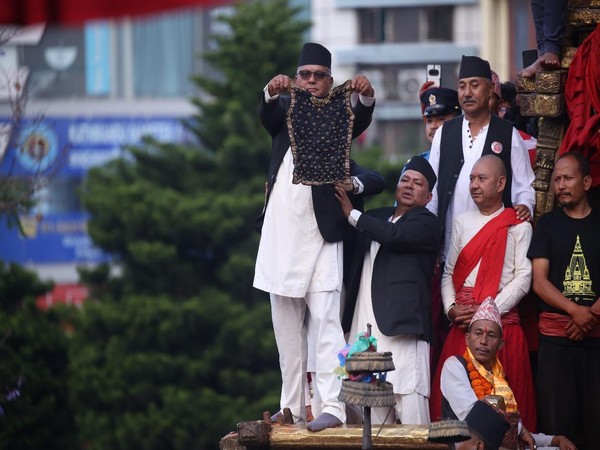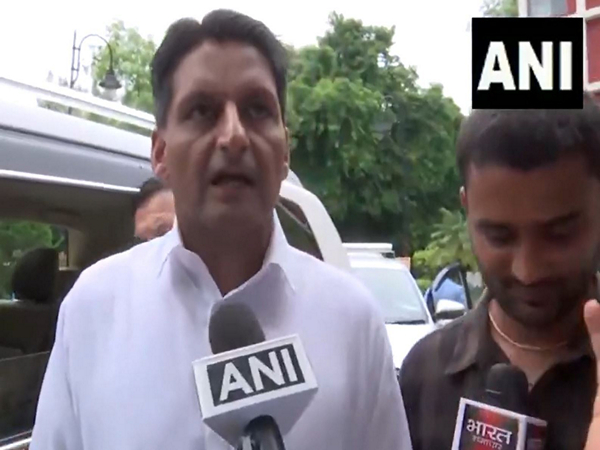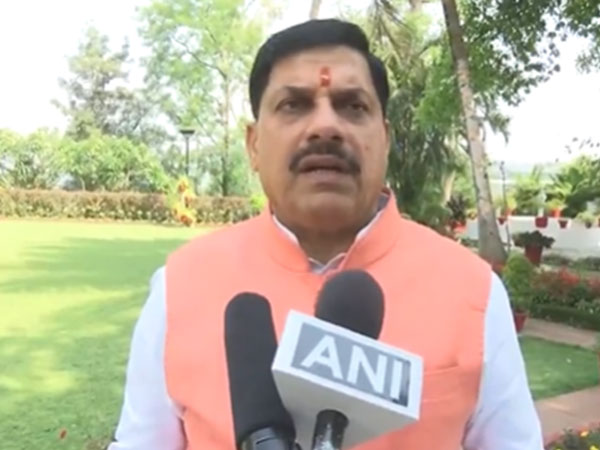Lalitpur [Nepal], June 2 (ANI): Nepal’s longest-chariot procession, dedicated of Rato Machhindranath, the valley’s “Red God” has concluded for the year with the showing of ‘Bhoto’ or the jewel-studded vest, which has remained unclaimed for ages.
The chariot procession of Rato Machhindranath is observed for at least a month to the four months’ end with showing the ‘Bhoto’, expecting the rightful owner to come and claim it.
Historians are yet to determine the exact origin date of Bhoto Jatra. However, many mention that the chariot procession of Machindranath started around 1,300 years ago. As the legend goes, shortly after the procession started, the queen of the serpent king Karkotak developed an eye ailment. While searching for a healer, Karkotak mistook a farmer working in the fields for a physician and brought him to Taudaha, a wetland on the outskirts of Kathmandu.
Frightened, the farmer prayed to Machhindranath and rubbed his hands on the soil to make an herbal paste. He offered it to Karkotak as medicine, and the paste cured the queen’s eyes. Grateful, Karkotak rewarded the farmer with a jewel-studded vest (photo) and returned him to the human world. The farmer began wearing the bhoto while working in his fields. One day, a ghost in human form stole the vest. The farmer searched everywhere but could not find it.
Later, while attending the Machhindranath chariot festival, he saw the ghost wearing the same vest and claimed it as his. When the ghost refused to return it, a dispute broke out. People summoned Karkotak to resolve the conflict. In the end, because neither party could prove ownership, they entrusted the bhoto to Machhindranath.
Since then, devotees have followed the tradition of displaying the bhoto after the chariot procession, hoping that someone with valid proof of ownership will come forward. Each year, they display the sacred vest on an auspicious date. According to legend, no one has succeeded in proving ownership of the bhoto so far.
Speaking to ANI, Rishil Shrestha, a festival goer, said, “The observance of the festival has passed down to generations. The Rato
Machhindranath Jatra starts from Pulchowk and after the entourage of the city, the chariot is finally brought here to Jawalakhel and the procession ends with the display of Bhoto.”
The Bhoto displayed annually at Jawalakhel in Lalitpur has pearls and jewels attached on it. The jewel-studded vest is packed and kept inside the cloth pouch for a year and opened only in the presence of Sthe tate head on particular day fixed by the priests when the Rato Machhindranath Jatra commences.
The showing of vest on that particular day shows it to be safe with the state, and who so over is the owner of the vest is to come and claim it. This practice which has run for a long now has become an integral part of month’s long festival. Along with, there also exists another myth about the commencement of the festival in Nepal’s oldest cities.
According to Hindu culture, there is a myth that yogi Gorakhnath (Founder of Nath Hindu) came to seek alms in Patan. The people of that region did not provide him with any alms. Hence, he became very furious and captured all the rain-causing serpent and
sat above them and meditated. There was no rain in Patan for ages. To solve problems, astrologers and Pandits advised the king to invite Machhedranath.
Machhedranath is believed to be teacher of yogi Gorakhnath; knowing that his teacher was in town, he went to meet him freeing all the serpents which resulted in plenty of rainfall. So, this festival is also claimed as the symbol of rain and fertility.
This festival is celebrated by pulling the wooden wheeled chariot along various parts of the city. A 60-foot-tall spire fabricated from bamboo poles raised from all four ends is carried by the chariot. (ANI)
Disclaimer: This story is auto-generated from a syndicated feed of ANI; only the image & headline may have been reworked by News Services Division of World News Network Inc Ltd and Palghar News and Pune News and World News
HINDI, MARATHI, GUJARATI, TAMIL, TELUGU, BENGALI, KANNADA, ORIYA, PUNJABI, URDU, MALAYALAM
For more details and packages















